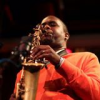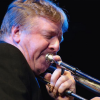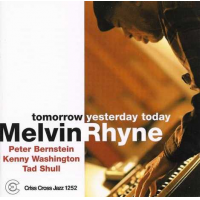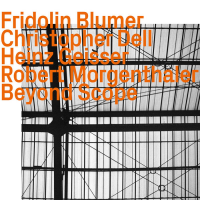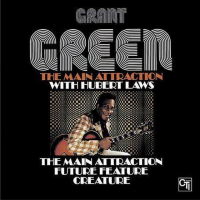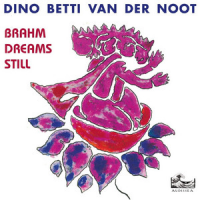Home » Jazz Articles » Liner Notes » Joe Chambers: Moving Pictures Orchestra: Live at Dizzy's...
Joe Chambers: Moving Pictures Orchestra: Live at Dizzy's Club Coca-Cola
Not so, for the ever-evolving Chambers. Moving Pictures Orchestra is irrefutable evidence that, in a new millennium, Chambers is looking to shine a greater spotlight on his inestimable skills as a composer, arranger and orchestrator. "I started writing early, at this very advanced high school for the time in Chester, next to Philly," Chambers explains. "I studied arranging and orchestration there, and when I moved to D.C. from '60-63, I was studying composition in university and playing in the clubs six nights a week."
After an early chance to apply lessons learned on some of Blue Note's most important albums of the mid-to-late '60s ("Alfred Lion and Francis Wolff didn't care what you played, as long as you put something in there they could put on the jukebox"), Chambers continued to hone his craft over the decades. Moving Pictures Orchestra's genesis is more contemporary, however, dating back to 2003 when Jazz at Lincoln Center commissioned Chambers to write two pieces for its Year of the Drum. "They were looking for a drummer/percussionist who could write and arrange for orchestra, and that happened to be me," Chambers says with unassuming nonchalance. "So I did this piece called 'Moving Pictures,' and it was successful, but I never really listened to it afterwards. Then, last winter, I asked them to send me a CD of the music and it sounded good, so I thought, 'I've gotta put this out.'"
With Chambers in Wilmington, NC, where he's been Tom Kenan Distinguished Professor of Jazz at UNCW since 2008, the drummer relied on trumpeter David Weiss to cherry-pick a 16-piece orchestra for a Dizzy's Club Coca Cola gig that includes a few familiar faces from previous Savant releases: bassist Dwayne Burno; pianist Xavier Davis'; percussionist Steve Berrios; and singer Nicole Guiland, reprising her guest appearance on Horace to the Max's "Mendacity," but in the context of Chambers' more expansive textural chart. "I specifically told David to get musicians of his generation," says Chambers. "These are New York players; they look at a chart and bam! They understand the concepts and can get right in it."
And get right in it, they do. From the opening "Prelude" of the four-movement, five-part "Moving Pictures" suite that bookends the disc, Chambers creates layered structures flexible enough to leave his orchestra room to manoeuvre—in this case trumpeter Josh Evans, whose opening solo sets a high bar for the rest of the set. The searing "Irina"—bearing absolutely no relation to Chambers' composition of the same name on Hutcherson's Patterns (Blue Note, 1980)—makes clear, in its final minutes, that Chambers' greater focus on writing and arranging has done nothing to diminish his vitality and imagination as a drummer. The more atmospheric "Ruth" better resembles the tune first heard on Hutcherson's Spiral (Blue Note, 1979) but, rhythmically recast, this atmospheric and episodic ballad, in addition to featuring Burno and Davis, is further evidence of Chambers' overlooked talent on vibraphone. Broken into two parts, the ritualized Afro-Cuban rhythm of "Clave de Bembe Part I (4th Movement)—rooted in the Santeria practice of the Yoruba people of West Africa—leads to the more fervent rumba of "Part II," closing the set with a monumental piano solo that takes the album to an incendiary climax before closing with a swirl of horns, reeds and flutes.
In between, an arrangement of "Tu-Way Pock-e-Way" by Italian saxophonist Mario Raja (the set's only non-Chambers arrangement) turns Chambers' programmed tune from The Outlaw into something more intrinsically organic, while Chambers' reverent look at Benny Carter's "Theme from 'M' Squad" is the closest he comes to the big band tradition. Chamber's arrangement of Joe Henderson's Afro-Cuban"Power to the People" is a highlight, turning the saxophonist's relatively spare sketch into a complex whirlwind of color and pulse. "It was a real challenge to orchestrate," says Chambers. "The line is asymmetric; it's not atonal but it is connected to a lot of synthetic scales. It's a full piece, with that melody line and vamp over the Phrygian in the middle, but I added the section where they're playing snippets of the melody floating over the rhythm, and throw several subordinate themes into the background."
With knockout performances from a band that also includes saxophonist Craig Handy and trombonist Conrad Herwig, whose soaring solos push "Power to the People" into the stratosphere, Chambers' focus remains on writing and arranging. "This is a milestone in my career," says Chambers, "my first recording of a large ensemble. I'm still playing, but I want to be known as a composer and orchestrator. There's not one drummer I can think of, throughout the history of jazz, who has led an orchestra as composer and arranger. Max Roach could have but he never did, and Max Roach-founded percussion ensemble in which Chambers remains a charter member), Chambers' place in jazz history may be assured, but how it's written is clearly still a work-in-progress.
Liner Notes copyright © 2026 John Kelman.
Moving Pictures Orchestra: Live at Dizzy's Club Coca-Cola can be purchased here.
Contact John Kelman at All About Jazz.
With the realization that there will always be more music coming at him than he can keep up with, John wonders why anyone would think that jazz is dead or dying.
Track Listing
Moving Pictures Suite: 1st Movement, Prelude, 2nd Movement, Irina, 3rd Movement, Ruth; Lonesome Lover; Power to the People; Tu-Way-Pock-E-Way; Theme from "M" Squad; Mendacity; Moving Pictures Suite: 4th Movement, Clave de Bembe, 4th Movement, Clave de Bembe II.
Personnel
Joe Chambers
drumsTim Green Saxophone
saxophone, altoSharel Cassity
saxophoneCraig Handy
saxophoneSam Dillon
saxophone, tenorFrank Basile
saxophone, baritoneFrank Greene
trumpetDavid Weiss
trumpetGreg Gisbert
trumpetJosh Evans
trumpetConrad Herwig
tromboneSteve Davis
tromboneJames Burton
tromboneMax Siegel
tromboneXavier Davis
pianoDwayne Burno
bassSteve Berrios
percussionNicole Guiland
vocalsAlbum information
Title: Moving Pictures Orchestra: Live at Dizzy's Club Coca-Cola | Year Released: 2012 | Record Label: Savant Records
Tags
PREVIOUS / NEXT
Support All About Jazz
 All About Jazz has been a pillar of jazz since 1995, championing it as an art form and, more importantly, supporting the musicians who make it. Our enduring commitment has made "AAJ" one of the most culturally important websites of its kind, read by hundreds of thousands of fans, musicians and industry figures every month.
All About Jazz has been a pillar of jazz since 1995, championing it as an art form and, more importantly, supporting the musicians who make it. Our enduring commitment has made "AAJ" one of the most culturally important websites of its kind, read by hundreds of thousands of fans, musicians and industry figures every month.



